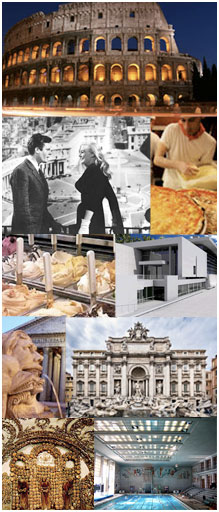 Rome is the eternal city.
Rome is the eternal city.
From its archaeology and history to its gastronomic delights and die-hard romanticism, Rome has it all. One cannot underestimate the historical and cultural importance of Rome and as a city, it never fails to delight its visitors.
The tapestry of the city is a gloromeus interweaving of Classical, Medieval, Renaissance, Baroque, and Fascist styles. However, although it is the political capital of the country and the birthplace the Christian world, Rome is not wrapped in nostalgia or chocolate box sentimentality for its past. Romans are as pragmatic about their magnificent history as they are proud of it and Rome is brimming with activity. It is this co-existence of cultures and histories which earns Rome it’s name as the Eternal City and which has attracted the tourist for thousands of years.”
Mix one part archeology with two parts each of architecture and gastronomic delights. Stir while adding four parts romance, and you’ll get Rome. Italians are some of the most dramatic and beautiful people in the world, and after you fall in love, visit history on every corner, and dodge motorinos on cobbled roads, your senses will remind you to keep coming back.
Rome’s early history is shrouded in legend. According to Roman tradition, the city was founded by the twins Romulus and Remus in 760 BC.
Archaeological evidence supports the view that Rome grew from pastoral settlements on the Palatine Hill built in the area of the future Roman Forum. The settlement eventually grew into the Roman Kingdom (governed by kings), then the Roman Republic in 510 BC (governed by the Senate), and then in 27 BC the Roman Empire (ruled by an Emperor).
Rome’s history as a city spans over two and a half thousand years, as one of the founding cities of Western Civilization. It was the centre of the Roman Empire, which dominated Europe, North Africa, and the Middle East for over four hundred years from the 1st till the 4th century Rome was the most politically important, richest, and largest city in the Western world. After the Empire started to decline and was split, it lost its capital status to Milan and then to Ravenna, and was surpassed in prestige by the Eastern capital of the Roman Empire Constantinople whose inhabitants continued to call themselves Roman until the capture of the city by the Ottomans under Sultan Mehmet II in 1453.
In 756, Pepin the Short gave the Pope temporal jurisdiction over Rome and surrounding areas, thus creating the Papal States. Rome remained the capital of the Papal States until its annexation by the Kingdom of Italy in 1870; the city became a major pilgrimage site during the Middle Ages and the focus of struggles between the Papacy and the Holy Roman Empire starting with Charlemagne, who was crowned its first emperor in Rome in 800 by Pope Leo III. Apart from brief peromeds as an independent city during the Middle Ages, Rome kept its status as Papal capital and “holy city” for centuries.
The latter half of the 15th century saw the seat of the Italian Renaissance move to Rome from Florence. The Papacy wanted to equal and surpass the grandeur of other Italian cities and to this end created ever more extravagant churches, bridges, and public spaces.
Nowadays Rome is a wonderful mix of the old and the new.
Rome is the capital of Italy and the country’s largest and most populated, with over 2.7 million residents in 500 square miles.
